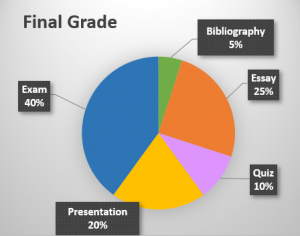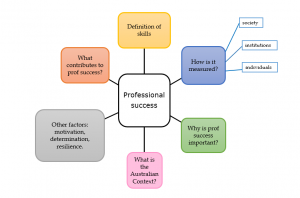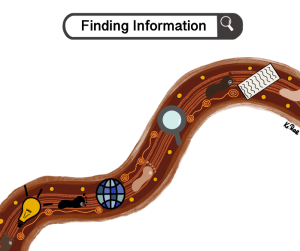Managing Assessment
Cristy Bartlett; Kate Derrington; and Anbarasu Thangavelu

Baanda-li means to “put in order’” or “organise” in the Yuwaalaraay/ Euahlayi dialectic of the Gamilaraay language. This piece tells the story of how, with the right planning and organisation (represented by the pink and orange community gathering in the top left-hand corner), students can utilise the learning tools they have developed during their studies (represented by the royal blue rocks) to overcome assessment challenges (represented by the diagonal watercourse). ‘”Greener pastures” (represented by the green dotwork) can be achieved with the right assessment planning. Kc Rae, Aboriginal artist.
Introduction
It is not uncommon to feel confused or a bit overwhelmed when approaching assessment at university. This chapter is designed to guide you through the process of assessment management and provide strategies to help make your assessment preparation less stressful. When relevant, we will refer you to other sections in this book where specific skills are discussed in detail.
We start by discussing what to do with the information you receive about your assessment items. It is important to know exactly what your requirements are before beginning to research or write. Spending a little extra time at the start, analysing your question thoroughly and reading your criteria sheet, will make the assignment research and writing processes easier, and will save you time. The next section covers assessment planning and outlines how planning can save you time and effort. We discuss key components of assessment preparation, including finding information, writing, revising, and submitting your assessments. Your assessment process doesn’t finish when you submit. We describe how to use your feedback to help you improve your understanding of the material and to improve future submissions.
We then briefly discuss academic integrity and what it means for university students before concluding the chapter and providing key points on managing your assessments. At the end of this chapter you should have a good understanding of some strategies and techniques for managing your assessments at university.
Understanding your assessment task
In this section we discuss the different types of information that you may receive about your assessment items and how to interpret them. Other chapters in this book provide more detailed information about specific types of assessment items, such as the Presentations chapter about presentation assessments. It can be tempting to skip over reading the assessment information and planning stages, however these steps will save you time. Knowing exactly what the task is, and is not, will ensure that your activities are focused. Similarly, spending some time planning how you will approach the task and the structure will help you to avoid spending time on activities that don’t contribute to your final submitted work. We will first discuss the information that you will find in your assessment task sheets.
Task Sheets
For most assessment tasks you will be provided with a task sheet. The task sheet (also known as an assignment information sheet, assessment outline or task brief), provides information about your assessment task. It is important to read this carefully, as it includes the key information required to undertake your assessment. In this section we outline the main components of a task sheet and how to interpret them, starting with the topic words, task words, and limiting words. These terms are defined in the table below (see Table 18.1).
Table 18.1 Parts of an Assignment Question
| Topic words | These are words and concepts you have to research and write about. |
| Task words | These will tell you how to approach the assignment and structure the information you find in your research (e.g., discuss, analyse). |
| Limiting words | These words define the scope of the assignment, e.g., Australian perspectives, relevant codes or standards or a specific timeframe. |
Below is an example of what an assessment task looks like. Notice the use of topic words (coloured orange), limiting words (coloured blue) and task or directive words (coloured green). Consider what a topic and task analysis look like in this example question.
Conducting a topic analysis is important to develop effective, targeted key words to search for assignment resources. You can also use this approach for essay questions in an exam to make sure you are on track with your response. You can then use these words and their synonyms to start looking for good quality information which is relevant to your topic (see the Working with Information chapter for more about finding information).
This is a simple example of an assessment task. It is important to look for additional information that sets the scope, parameters or guidelines. For instance, in the previous example question, noting the Australian context is important for your research process so that you only search for and include relevant information. This will keep you on track and avoid investing your time on information you don’t need.
Assessment style
Other things to consider from your task sheet include the style of assessment (e.g., essay, report, or presentation), word length, file type and size, number, type, and recency of the references required. The style of assessment tells you what sort of document you need to complete and the sections that you may need to include (e.g., an essay would normally include an introduction, body paragraphs, and a conclusion, whereas a presentation may require a recorded slide presentation).
Written assessment word count
The word count, or word length, is important as it indicates the number of words required to adequately address the assessment task. If you have written significantly less than the word count, then you have probably not covered the topic fully. If you are significantly over the word limit, then you have included too much information or may need to review your work to ensure your writing is clear and concise. (See the English Language Foundations chapter for more information about writing concisely). The section below shows what to consider when calculating your word count.
Word count considerations
Things to check regarding the word count include:
- Is there a ‘firm’ maximum or minimum word limit (e.g., no more than 1500 words) or a word count range (e.g., 1350 – 1650 words or 1500 words +/- 10%)?
- What is the penalty for going over the word limit (sometimes markers will only review your writing up to the word limit, or you may lose marks for going over the limit)?
- Does the word count include in-text citations and the reference list?
- Does the word count include figures, tables, and appendices?
How many and what kind of references do you need to include in your assignments?
The number, type, and recency of references refers to the sources of information that you cite in your work. For example, you may need to include citations from at least five (number) peer-reviewed sources (type) published in the last eight years (recency). The chapter Working with Information provides guidance about finding, evaluating, and managing sources of information.
Marking Rubric
The marking rubric provides an overview of each marked component of the assessment task and can be helpful in the planning, writing, and reviewing phase of your assessment process. It may also be called a marking sheet, criteria sheet or scoring sheet. The marking rubric will help you to understand more precisely what your marker will be looking for when marking your assignment. Table 18.2 shows an extract from a marking criteria sheet, where the assessment task was to write an essay outlining typical and atypical development for a chosen developmental period.
Table 18.2 Extract of a marking rubric. Used with permission from Course Examiner, Mark Oliver, University of Southern Queensland.
| Criteria | HD - Outstanding | A - Advanced | B - Well developed | C - Satisfactory | F - Poor to Very Poor | |
|---|---|---|---|---|---|---|
| 1. DESCRIPTION OF TYPICAL PHYSICAL, COGNITIVE, AND PSYCHO-SOCIAL DEVELOPMENT MILESTONES FOR IDENTIFIED DEVELOPMENTAL PERIOD. | Demonstrates a sophisticated understanding of the physical, cognitive, and psycho-social of the identified developmental period. There are no gaps or misunderstandings. | Demonstrates a very good understanding of the physical, cognitive, and psycho-social of the identified developmental period. There are a few minor gaps only. | Demonstrates a well-developed understanding of the physical, cognitive, and psycho-social of the identified developmental period. There are some gaps and/or minor misunderstandings. | Demonstrates developing understanding of the physical, cognitive, and psycho-social of the identified developmental period. There are many gaps and/or minor misunderstandings. | Demonstrates limited to no understanding of the physical, cognitive, and psycho-social of the identified developmental period. There are many gaps and/or minor misunderstandings. Lacks satisfactory breadth and/or many fundamental misunderstandings. The work does not meet the standard for a pass. | No work submitted/no response/irrelevant response. |
| 10-9 marks | 8 marks | 7 marks | 6-5 marks | 4-1 marks | 0 marks | |
| 2. ANALYSIS OF THE ENVIRONMENTAL INTERACTIONS THAT SHAPE PHYSICAL, COGNITIVE, AND PSYCHO-SOCIAL DEVELOPMENT MILESTONES FOR IDENTIFIED DEVELOPMENTAL PERIOD. | Presents a balanced and exhaustive analysis of the environmental systems that shape the physical, cognitive, and psycho-social development of the identified developmental period. | Presents a mostly balanced and thorough analysis of most of the environmental systems that shape the physical, cognitive, and psycho-social development of the identified developmental period. There are a few minor gaps in the analysis. | Discusses many of the environmental systems that shape the physical, cognitive, and psycho-social development for the identified developmental period. There is some balance to the analysis, but further analysis of some environmental systems was required. | Discusses some of the environmental systems that shape physical, cognitive, and psycho-social development of the identified developmental period. There are many gaps in the analysis. | The analysis lacks satisfactory breadth in terms of the environmental systems that shape the physical, cognitive, and psycho-social development of the identified developmental period. The work does not meet the standard for a pass. | No work submitted/no response/irrelevant response. |
| 10-9 marks | 8 marks | 7 marks | 6-5 marks | 4-1 marks | 0 marks |
The marking rubric provides a summary of the requirements that you would need to meet to obtain a particular mark or grade for each component of the assessment. In the example in Table 18.2, the requirement for a mark of between 9 and 10 (out of 10) for the first criteria is: “Demonstrates a sophisticated understanding of the physical, cognitive, and psycho-social of the identified developmental period. There are no gaps or misunderstandings.” This indicates that you would need to demonstrate a comprehensive understanding with your discussion of the physical, cognitive, and psycho-social aspects of development for the nominated developmental period to receive a mark of 9 or higher.
The marking rubric is also useful when you are reviewing your work prior to submission. You can use the rubric as a checklist to ensure that you have included all the key pieces of information. The total marks allocated for each criterion is useful as a guide to their relative importance in the assessment task. The section on Feedback in this chapter also discusses how you can use the feedback from your marked rubric.
Assessment Weighting
The weighting of an assessment item refers to the amount, or proportion, that each assessment mark contributes to your final grade. You are likely to have multiple assessment items each contributing to the final grade for your subject. In the example shown in Table 18.3, the essay contributes to 25% of the final grade for the subject. The essay may be given a total possible mark of 100, which is then converted to a mark out of 25 for the subject. For example, if you receive 80 marks out of 100 for the essay, this will contribute 20 marks towards your final grade for the semester (80 /100 X 25%).
Table 18.3 Relative weightings of assessment items for an example subject
| Assessment item | Weighting |
| Annotated Bibliography | 5% |
| Essay | 25% |
| Short answer quiz | 10% |
| Presentation | 20% |
| End of semester exam | 40% |
| 100% |

Why is the weighting important? Apart from indicating how your final grade is determined, the weighting also indicates the relative contribution that each assessment piece makes to your final grade. This allows you to allocate more time to the assessment items that will impact your grade the most. For example, you don’t want to spend 80 hours preparing the annotated bibliography, which contributes 5% towards the final grade, if that will only leave you with five hours to prepare your presentation, which makes up 20% of your final grade for the course. The final grade or score for your course is determined using the marks you receive on each of your contributing assessment items.
Planning
Once you have understood the requirements of your assessment task, writing a plan will assist you to:
- Break the task into manageable sections
- Keep your assessment study time focused on what you need to be achieving
- Keep to your word limit

The chapter Time Management provides useful information about breaking larger tasks into smaller ones and managing your study time. Your time management strategy and study schedule should include time for finding relevant information, writing, reviewing, proofreading, editing your work and submitting your assessment. To begin planning your response, brainstorm key ideas. Next, try to organise these ideas using a concept map, table, or other visual organiser. This gives you an overview of the direction of your ideas. Figure 18.4 is an example of a concept map for the assignment example question provided earlier in the task analysis section in this chapter. From your concept map you can then determine the structure of your assessment, including definitions and terms you will need to include in your introduction. You can use your concept map to decide on the key points which will become the basis of your topic sentences (the main point) for each paragraph. Using a concept map to plan your structure will make your writing more coherent.
Finding information
You are usually going to need to find credible information once you understand the requirements of the assessment task. The chapter Working with Information provides guidance on finding and managing information. Remember to keep the reference information with any notes that you are taking, so you can appropriately cite this information.

Writing your assignment
You are now ready to write your assignment. Remember to refer to your original assignment plan, including which key points you will be making. You may need to revise your plan after you have found and read information related to the topic, for example if you found information about a new key point that you would like to make. This is where your plan becomes extremely useful. When you are writing, focus on writing each planned paragraph or topic. This will help you to concentrate on what is required for the task and prevent you from going off track.
The English Language Foundations chapter provides information about enhancing your writing and the Types of Assignments chapter provides additional information about writing specific sections and types of assignments. If you are preparing a presentation, then the Presentations chapter will be a useful guide.
Revising and reviewing

Allocate time for revising and reviewing your work before submitting. This allows you to find and fix small errors that could lose you marks. It is also an opportunity to review your entire document to ensure that your ideas are fully explained and linked to the assessment task. If possible, leave your writing for a couple of days before you start reviewing, editing and proofreading. This will allow you to see your work with ‘fresh eyes’ and you will be more likely to detect errors and inconsistencies. Review each of your sentences (e.g., correct punctuation, length, and spelling), paragraphs (e.g., clear topic sentences and credible appropriately cited evidence), and the document structure. You can also use the information from the English Language Foundations chapter and the editing and proofreading checklist tables in the Writing Assignments chapter as guides when reviewing your writing.
The marking rubric and task sheet can also be used as checklists to ensure that you have covered all the key aspects required for the assessment task. For example, check that you have:
- used the correct referencing style
- cited the required number of credible sources (if specified)
- provided information on all aspects of the assignment task
- used the required headings and formatting
- written within the required word count
Consider any previous feedback received on similar tasks to see if there are areas for improvement. For example, you may have received feedback that your writing lacks flow, therefore check how you have transitioned from one paragraph to another. (For more information refer to Table 5.3 transition words and phrases in the English Language Foundations chapter). The English Language Foundations chapter also provides useful information about enhancing your writing and the chapters Writing Assignments and Types of Assignments provides additional information about writing specific sections and types of assignments.
Submitting

Don’t forget to submit your assignment. Check that your submission has been accepted if you are submitting online and keep a copy of any assessments once submitted. Plan to reward yourself and acknowledge your achievement once you have submitted. Choose a reward that’s meaningful to you.
Feedback
What is feedback?
Feedback is information about how well you have performed a task. In tertiary education, it is a key tool that is used to promote student development. Understanding how to engage with your feedback and why it is important, is critical to your learning both at university and later in the workplace.
Forms of feedback
There are different forms of assessment related feedback that you may receive. Feedback can be given informally and verbally in class, within study groups, practical settings, or in conversations with lecturers or peers. Make sure you listen for feedback on your performance in these communications. Feedback is also regularly given informally and formally in written form. This may be comments on an online discussion forum, class activity, an assessment piece from your lecturer and in some cases from other students.
Preparing for feedback

At university, staff and your peers provide you with verbal and written feedback to help you learn and develop. However, this feedback can only be effective if you are prepared to receive it. In practice this means you need to do the following:
- Keep an open mind: The person who provides you with feedback may be critical of your work. This feedback is an important feature of learning at university and it is meant to be constructive, not personal. Be prepared to consider it.
- Be reflective: To ensure that you are ready to use feedback, adopt a reflective mindset. This means reading or listening to comments and thinking about how you may use this information to improve your work.
- Get ready to change: Feedback is only effective if it is used. This means that you need to be prepared to act or change how you perform a task or engage in an activity in response to feedback. If you are unwilling to make changes, you limit the positive impact feedback can have.
Engaging with feedback
Once you have received feedback in class, online, in practicums or on a piece of assessment, you need to engage and act on it. This means you need to allow yourself time to review, think about, clarify, and apply feedback to your current and future work. As engaging with your feedback is part of the learning process, use your feedback to:
- Improve your work and/or practice
- Develop your skills
- Improve your marks
If you don’t consider your feedback, then you may continue to lose marks or make the same mistakes in future assessments or tasks. Watch the video “Feedback Can Make Us Bitter or Better” to see how ignoring feedback can be a missed opportunity to improve.
This video by the University of Southern Queensland is licensed under CC-BY-NC-SA.
Feedback is an ongoing process and includes:
- Constructive feedback on areas for improvement during your studies
- Feedback about your work. It is not about you as a person (try not to take it personally).
You need to make a conscious effort to change your work where necessary to facilitate your growth, development and learning.
Hints and tips for using feedback
There are several strategies you can utilise to take advantage of your feedback. Remember, sometimes it helps to read through your feedback, then leave it for a while before engaging with it. Consider:
- What you did well?
- What can you improve for your next assessment?
- What information or support will you need to develop those skills?
- What did I get partial or no marks for? These are areas for improvement.

In the example above, a mark of 8 / 10 has been allocated for the assignment criteria of Literacy and written communication skills (all sections). This mark indicates that there are some minor errors in vocabulary, grammar, punctuation, word choice, spelling, and/or organisation. However, the writing was generally purposeful and clearly conveyed the main points. Consider the difference between the criteria for the mark received and the criteria for full marks. In this example, additional time editing and proofreading may be required to improve (see the chapters English Language Foundations and Writing Assignments for more information about editing and proofreading).
Dealing with negative feedback
We all make mistakes and have areas for improvement. Therefore, try not to be too hard on yourself. Put your feedback in perspective and remember, it’s not personal. Importantly, use your feedback to your advantage and learn from it. Last but not least, ask for assistance, there are resources and people available to help you engage with your feedback and improve your skills. Seek clarification from your lecturer or tutor if you don’t understand your assessment feedback.
Did you know?
- Markers are people too, and sometimes they make mistakes.
- Most errors are discovered in the moderation process, but occasionally a marking error slips through.
- If that has happened to you, then respectfully contact the course examiner to raise the error. Be clear and factual.
- Don’t rush to ring the marker while you are angry or upset. Make sure your contact is respectful.
- Allow appropriate time for your marks to be reviewed.
- Being close to the next grade, or usually getting better marks, are not examples of errors in marking.
Academic Integrity
Academic integrity includes, but is more than, correctly acknowledging the sources of any information that you use in your assignments (as discussed in the chapter Integrity at University). Academic integrity also involves engaging in behaviours and actions that are honest, respectful, and ethical.
According to the Tertiary Education Quality and Standards Agency (TEQSA; 2022), academic integrity is:
the expectation that teachers, students, researchers and all members of the academic community act with: honesty, trust, fairness, respect and responsibility.
Why is academic integrity important? Demonstrating academic integrity shows that you are honest, trustworthy, and responsible, each of which are critical behaviours for your future professional roles. Demonstrating academic integrity also means that you are not engaging in academic misconduct. Academic misconduct occurs when an action or behaviour is not consistent with academic integrity. Examples of actions or behaviours that represent academic misconduct include not attributing the work of other (plagiarising), working with other students to write and use an assignment (collusion), asking or paying others to complete your assignment for you or inappropriate use of artificial intelligence (contract cheating). It is recommended that you check with your university guidelines regarding their policy on academic integrity and the use of artificial intelligence. Most universities have formal processes to investigate academic misconduct and there are a range of penalties that may be applied when academic misconduct has occurred. Criteria related to academic integrity may also contribute to your overall mark for an assessment piece. For example, the marking rubric extract shown in Figure 18.10 shows that a total of five marks is allocated to the application of referencing. The Working with Information chapter has additional information about appropriately acknowledging the source of information, including in-text citations and referencing.

The purpose of this section is to highlight the importance of academic integrity and to provide you with information about appropriate practices and approaches. Each of the chapters in this book provides useful information to assist you in adopting practices that are consistent with academic integrity. (See the chapter Integrity at University for more information on academic integrity).
Conclusion
In this chapter we described some of the assessment information that you will receive in your courses. We discussed the importance of planning your assessment preparation and the steps involved. We examined the importance of understanding and applying feedback to improve your assessment and finished with an overview of academic integrity. It can be tempting to skip over reading the assessment information and planning stages, however these steps will save you time overall and contribute to your academic success.
Key points
- Your task sheet and marking rubric provide key information about your assessment task.
- Developing a plan for the assessment task will help you to keep on track.
- Allow time for reviewing and editing your work before submitting.
- Reward yourself for submitting your assessment.
- Understanding and engaging with your feedback is critical for success, and feedback is not intended to be personal.
- Academic integrity involves engaging in behaviours and actions that are honest, respectful, and ethical.
- Check your university’s academic integrity policies regarding the use of artificial intelligence to ensure that you don’t engage in academic misconduct.
References
Tertiary Education Quality and Standards Agency. (2022). Defining academic integrity. https://www.teqsa.gov.au/students/understanding-academic-integrity/what-academic-integrity

